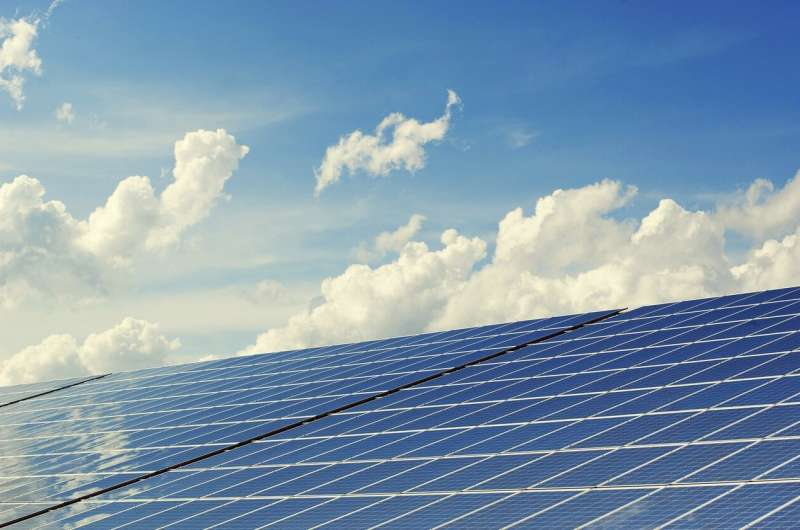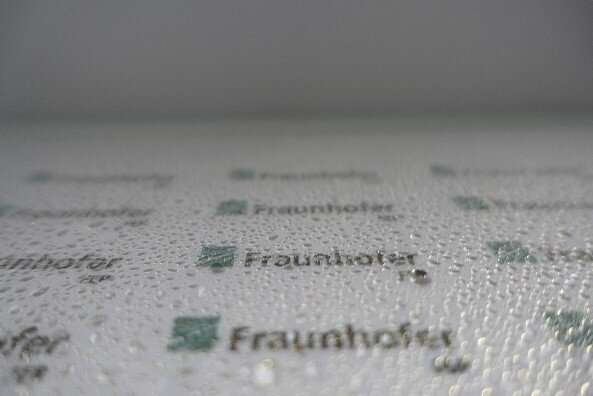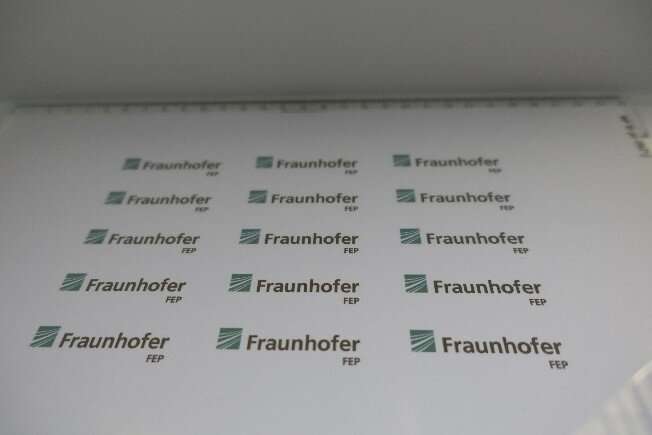by Franziska Lehmann, Fraunhofer Institute for Organic Electronics, Electron Beam and Plasma Technology

Cleaning glass facades and solar installations is expensive and time-consuming. Dirt reduces the yield of solar modules. However, the Fraunhofer Institute for Organic Electronics, Electron Beam and Plasma Technology (FEP) has now succeeded in applying crystalline titanium oxide to ultra-thin glass using a roll-to-roll process, thus achieving hydrophobic surfaces that become superhydrophilic under UV light.
Initial results of this showcase of some of the NewSkin open access upscaling facilities will be presented at the Fraunhofer joint booth, No. C2-528, during BAU 2023, April 17–22, in Munich, Germany.
In 2021, photovoltaics covered 8.9% of gross electricity consumption in Germany with electricity generation of 50 TWh. This percentage must increase to reach a sustainable energy transition. Dirt-repellent, easy to clean surfaces ensure transparency and cleanliness for facades, and more efficient and consistent energy production for solar power, with lower maintenance costs.
“We are focusing on photoinduced hydrophilicity on surfaces here,” explains graduate student Valentin Heiser from FEP. “To upscale this effect, we apply crystalline titanium oxide to ultrathin glass in a roll-to-roll process for the first time. This is very efficient. The ultrathin and lightweight glass can be applied subsequently to facades or directly incorporated into solar modules as a composite material—and even onto curved surfaces.”
Titanium dioxide changes its hydrophilicity, i.e., its water repellency, when exposed to UV radiation (e.g., activation by sunlight). Unirradiated, it is hydrophobic, meaning it forms water droplets. After irradiation, it is superhydrophilic, or completely moistened. In the case of photoinduced hydrophilicity, the surface changes from hydrophobic to superhydrophilic after approximately 30 minutes of irradiation with sun-like UV light.

On surfaces with this titanium dioxide coating, no or only very little dirt can be deposited. For example, if traffic dust, sand or other dirt is deposited on glass facades or solar panels, it is washed off by the nightly hydrophobicity of the surface via beading raindrops. In addition, the cyclic alternation of hydrophobic and superhydrophilic properties means that the dirt does not adhere to the surface during the day.
Titanium oxide activated with UV light also decomposes organic molecules on the surface by photocatalysis. This produces antibacterial and sterile surfaces that are of particular interest in medical technology or in connection with flexible displays.
The researchers at Fraunhofer FEP have now developed the first coatings: Specifically, a 30-cm wide and 20-m long roll of thin glass, with a glass thickness of 100 micrometers, was coated with 30–150 nanometers of titanium oxide in a roll-to-roll system. This pilot plant for roll-to-roll coating of thin glass (FOSA LabX 330 Glass from VON ARDENNE) is located at Fraunhofer FEP.

One challenge for this showcase project is that thin glass is a very new substrate with significant handling requirements, as it breaks very easily and reacts sensitively to thermal and mechanical stresses. Second, titanium dioxide achieves its special properties of hydrophobicity and hydrophilicity only when it is crystalline. For this, it requires high temperatures during production. Sputter coatings with these requirements could not be implemented in roll-to-roll technology until now because common substrates, such as films, could not withstand the high temperatures. This is where thin glass provides an alternative.
Thanks to this work through NewSkin, Fraunhofer FEP scientists are now working on combining the properties of titanium dioxide and thin glass in an optimal and cost-efficient way in order to bring innovative products to market together with industry. Researchers from Uppsala University, a partner of NewSkin, are working on transferring the results even to polymer films.
In the future, work will also be done by Fraunhofer FEP on layer systems that can be activated not only with UV light but also with visible light. The production and embedding of nanoparticles or doping with nitrogen, for example, are also being considered.
Provided by
Fraunhofer Institute for Organic Electronics, Electron Beam and Plasma Technology
Citation:
Retrofitting facades and solar panels easily with ultra-thin glass (2023, January 25)
retrieved 25 January 2023
from https://techxplore.com/news/2023-01-retrofitting-facades-solar-panels-easily.html
This document is subject to copyright. Apart from any fair dealing for the purpose of private study or research, no
part may be reproduced without the written permission. The content is provided for information purposes only.
Stay connected with us on social media platform for instant update click here to join our Twitter, & Facebook
We are now on Telegram. Click here to join our channel (@TechiUpdate) and stay updated with the latest Technology headlines.
For all the latest Technology News Click Here
For the latest news and updates, follow us on Google News.
